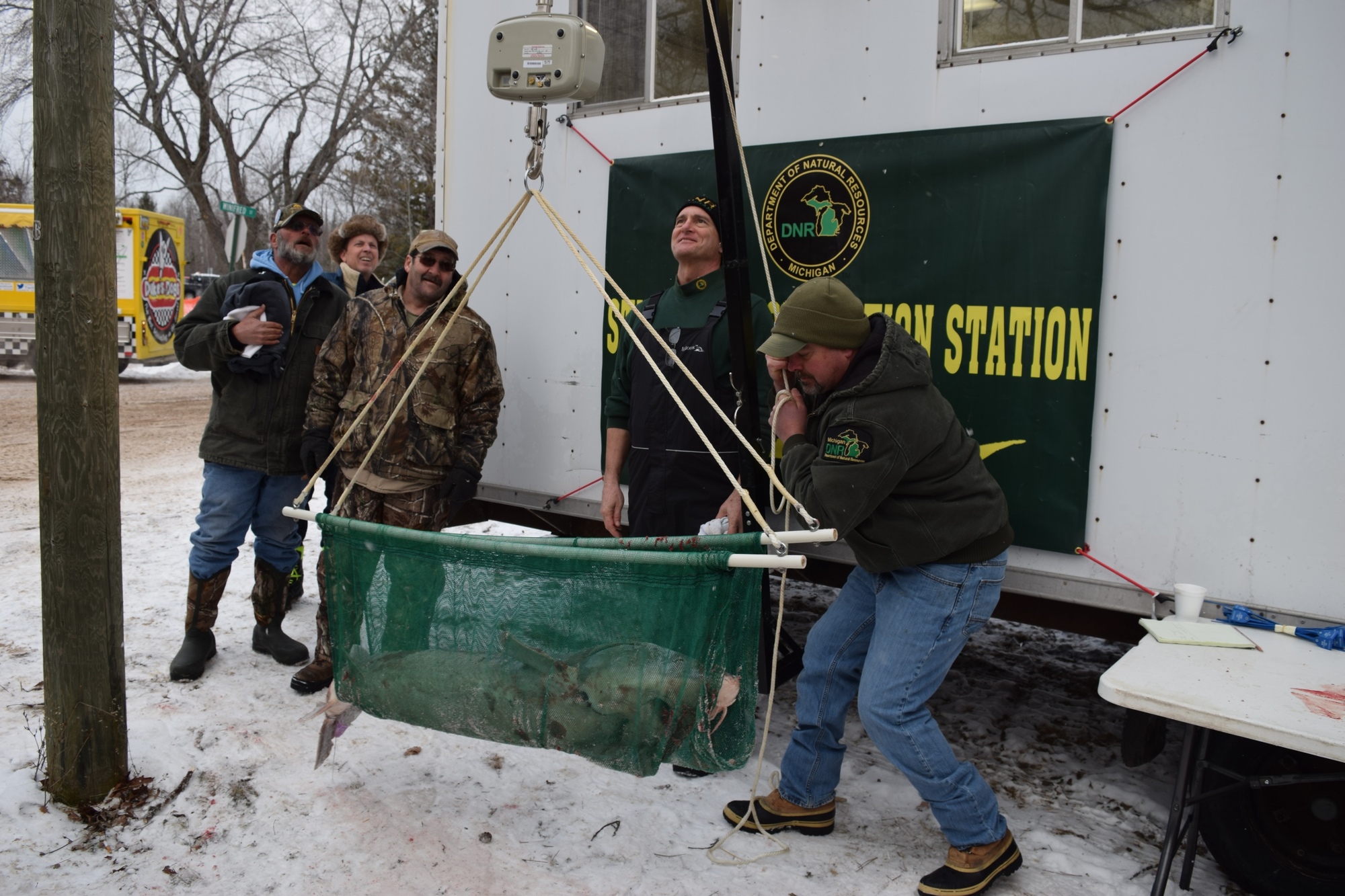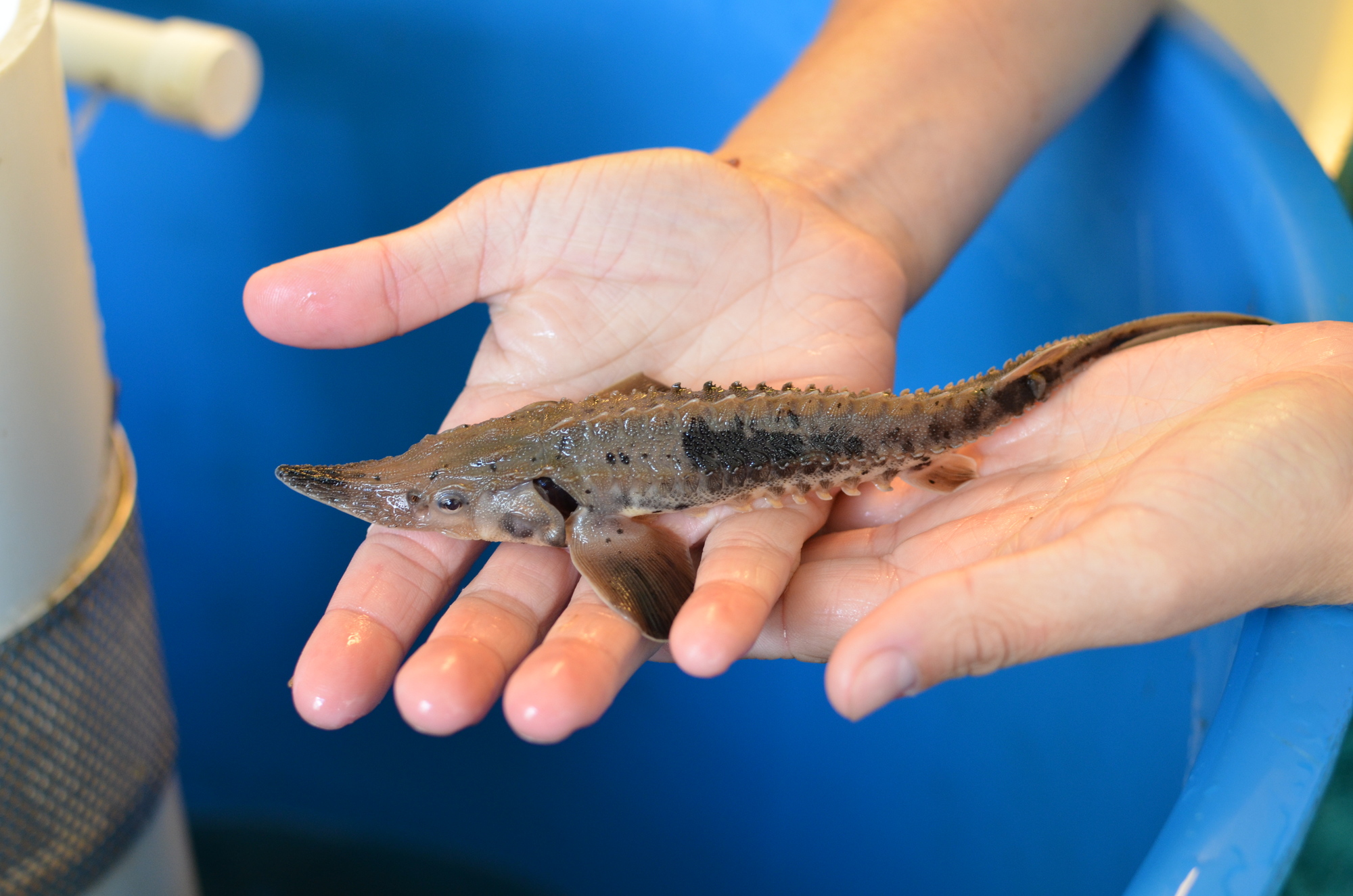Black Lake Sturgeon What to Do With After Spearing
Black Lake sturgeon spearing tradition continues in Cheboygan Canton

The Lake sturgeon is an aboriginal fish species that inhabits large river and lake systems in the Keen Lakes Basin and elsewhere.
These monstrous fish can grow upward to 7 feet long and weigh 200 pounds, providing Michigan claw-and-line anglers trying to catch them an extraordinary thrill.
They are the largest fish native to the Groovy Lakes, and because of habitat loss – by and large the loss of spawning habitat by the creation of dams – and overfishing in the past, the lake sturgeon is a threatened species in Michigan. Specific regulations limit sport fishing, and no commercial harvest is allowed.
Only at Black Lake in Cheboygan County can sport anglers utilise spears to harvest a sturgeon. At that place is a strict quota limiting total angler accept and, individually, anglers tin can harvest only ane sturgeon per season.
Across Michigan, fishing seasons for lake sturgeon can extend several months, depending on the water body, merely the Blackness Lake season often lasts only a matter of hours.
This year's flavour, which just recently concluded, was no exception.
The wintertime Black Lake sturgeon season opens the first Sabbatum in Feb and continues through the following Wed, or until the quota is reached, whichever comes start.
For 68-year-one-time Gil Archambo, opening day started early.
He was up at 3 a.m., getting the dozen of shanties he rents or loans to anglers prepare to become. He then helps transport anglers out to the spearing grounds for the 8 a.m. season offset.
"It's bigger than information technology's ever been," said Archambo, who has been renting shanties to those who spear sturgeon about his entire life. "There'due south more interest and enthusiasm than e'er."
Archambo said conditions conditions shifted favorably, but in time for the flavor.
"Last week, when it warmed up, there was no way yous could get a shanty out there anywhere on the lake, and information technology didn't wait like there would be many shanties out at that place," he said. "Just it froze upwardly the last couple of days before the flavor and it worked out like a champ. Everything went real well. I don't think information technology could have been any better."
wait like there would be many shanties out at that place," he said. "Just it froze upwardly the last couple of days before the flavor and it worked out like a champ. Everything went real well. I don't think information technology could have been any better."
Sturgeon flavor lasted just a niggling longer than an hour this year, which isn't unusual in recent seasons. Given the relatively low resource allotment of 7 fish allowed, more than 300 anglers signed up to participate, every bit well equally good water ice weather condition, clear h2o and fish moving, Archambo said he figured it might not fifty-fifty last that long.
There were 332 registered anglers on the ice, upward from 261 in 2016. Angler registration since 2010 has ranged from 197 to 332. Well-nigh anglers pre-registered Friday, February. 3, allowing for a more than streamlined process.
Fishing for sturgeon on Black Lake has become a must-attend upshot. Non only do hundreds participate, merely thousands more show upwardly to sentinel, and to celebrate the mysterious fish that have lived in Black Lake since dams trapped these Great Lakes denizens inland decades ago.
"This is the sturgeon population nosotros feel the nigh confident in," said Dave Borgeson, Michigan Department of Natural Resources unit managing director for the Northern Lake Huron Management Unit. "It's get one of the nearly-studied sturgeon populations in the world. Nosotros've expended a lot of endeavour to figure what's going on hither, and we're on what we recall is a path to recovery."
Not many years ago, Michigan fisheries biologists considered the Black Lake sturgeon population imperiled. Long-lived fish that accept decades to attain sexual maturity and don't spawn every year, Black Lake sturgeon were not reproducing every bit quickly every bit they were being harvested.
 A 1997 survey indicated the population had shrunk to but over 500 adults from a population in one case estimated at 1,600. It caused the DNR to ponder closing the lake to spearing.
A 1997 survey indicated the population had shrunk to but over 500 adults from a population in one case estimated at 1,600. It caused the DNR to ponder closing the lake to spearing.
But the expanse residents, who consider sturgeon spearing an integral part of the local culture, dedicated themselves to preserving this population of primitive fish. They formed Sturgeon For Tomorrow, a non-profit organisation dedicated to patrolling the Black River where the large fish spawn in the spring, to guard spawning sturgeon from poachers.
In addition, the DNR partnered with others – including Michigan State University and Tower Kleber LP (owner of the Black River dam) – to build a hatchery facility to requite the sturgeon population a helping hand. The results have been dramatic.
"Our current estimate after last spring's run was 1,113 adults, basically double," Borgeson said. "Every year nosotros're learning at that facility. We've learned that if we stock them at six inches or greater, nosotros go really skilful survival of fish. Nosotros've even reduced our stocking rate considering the survival rate of stocked fish is higher than originally idea.
"We're not seeing huge increases in adults yet, merely what's different now is we've got lots of year classes of younger fish represented. The age distribution is representative of a healthy population. Our ultimate goal is to become a naturally reproducing population."
The DNR uses a model that takes into account harvest from a given year and population data to produce a harvest quota for the following twelvemonth.
Based on the makeup of the population, fisheries managers figured anglers could harvest 14 fish this winter – roughly one.ii percent of the adult population – a quota divided evenly between state-licensed anglers and tribal fishermen.
The DNR has experimented with how to classify the quota over the years and, in contempo seasons, has allowed unlimited access.
"We've been able to monitor the fishery closely enough that we can shut it down," Borgeson said. "So whoever wants to come to fish for sturgeon can register and come out – knowing that it could exist a very short season."
This year, things started chop-chop.
At 8:10 a.grand., Brett Trepanier of Onaway saw a fish swim into his hole, on the lesser in 14 feet of water, then stop.
"I had to walk to the other side of the pigsty to spear it," the 35-year-old auto body shop owner said. "I hit information technology and I thought it was going to pause the spear – you could hear it keen. It got all tangled up in the decoy line and the spear rope. I couldn't even get out of my shanty."
As soon equally he could, Trepanier notified fisheries officials and brought the 78.3-pound behemoth into the headquarters.
Minutes later, 34-year-old Scott Ash, a ranch caretaker from Onaway, speared a 72-pound, 67-inch sturgeon simply a few yards away from Trepanier. It was Ash'due south second sturgeon; he speared one in 2014.
"It came in on the lesser, in sixteen feet of h2o," Ash said, proverb he speared the fish and it didn't fight at all.
That's quite a contrast to Rick Taylor'southward experience. The 38-twelvemonth-erstwhile carpenter from Fostoria had to struggle to get his fish off the bottom.
"I looked downward the hole, saw it, threw the spear and got information technology in the tail," he said. "I told my buddy to go become the other spear and he got it in the head and nosotros hauled it out."
Taylor'due south buddy, 40-twelvemonth-old Dave Osborn, said, "I'g but happy to exist a part of information technology."
Benjamin Archambo, Gil'south nephew, speared a small-scale (14.9 pounds) male in short society, perchance fifty yards from Taylor. It was the quaternary fish he'd seen that morning.
At 9:05 a.one thousand., with a sixth fish reported, the DNR began notifying anglers that the season was closed, only two more fish were on the ice within the next 2 minutes before anybody could be notified.
That put the state anglers i over the quota. While Borgeson said this is not a desired outcome, there is an agreed-upon system in place to accost the situation.
 Cole Hudson, a 13-year-onetime seventh grader from Bishop Baraga School in Cheboygan, was the last to check in with a 33-pound, 55-incher. He had been fishing with his father.
Cole Hudson, a 13-year-onetime seventh grader from Bishop Baraga School in Cheboygan, was the last to check in with a 33-pound, 55-incher. He had been fishing with his father.
It was a far weep from the state tape, which was 193 pounds, 87 inches, taken from Mullet Lake in 1974. However, Hudson said this fish is ane he'll recollect for a long, long time.
DNR fisheries biologists said six female person and two male person lake sturgeon were harvested this yr at Blackness Lake. The females ranged in length from 55 inches to 67 inches and 33 pounds to 79 pounds. The two males were 46 inches and 59 inches and weighed fourteen pounds and 42 pounds, respectively.
Vi of the eight fish had some sort of identifiable tag from previous years, providing the DNR with valuable information regarding spawning regularity and fish growth.
An instance of this is 1 fish caught by the DNR in 2001, when it measured 61 inches long. It was speared this year and measured 62.five inches, illustrating simply how slowly sturgeon grow, especially once they get big.
To further illustrate that indicate, one sturgeon was captured and tagged initially in May 2006 at 66 inches. It was harvested this month measuring 66.7 inches. Another fish was tagged in May 2001 measuring 62 inches, and measured 67 inches this month. Still another sturgeon was tagged in May 2009 at 64.v inches, and harvested this month at 65.five inches.
The DNR continues to provide an open fishery for lake sturgeon while still recovering the species in the Black Lake watershed. The state's current harvest rate of 1.2 percentage of the population is a safeguard against over-harvest.
This is a charge per unit that has been agreed on in the past with tribal governments. In addition, annual stocking and protection of adults in the river during spawning help to keep building the population.
Rehabilitation of lake sturgeon in the Cheboygan River watershed is a cooperative effort involving the DNR, the Black Lake Chapter of Sturgeon For Tomorrow, Michigan State Academy, Tower-Kleber Express Partnership, the Bay Mills Indian Customs, the One thousand Traverse Band of Ottawa and Chippewa Indians, the Little River Band of Ottawa Indians, the Niggling Traverse Bay Band of Odawa Indians and the Sault Ste. Marie Tribe of Chippewa Indians.
A Black Lake Sturgeon Rehabilitation Programme was recently approved, having been crafted by the DNR and representatives of the 5 tribes.
For more information on the history of Michigan's lake sturgeon and angling for sturgeon in the state, visit www.michigan.gov/sturgeon.
Source: https://www.outdoornews.com/2017/02/16/black-lake-sturgeon-spearing-tradition-continues-cheboygan-county/
0 Response to "Black Lake Sturgeon What to Do With After Spearing"
Post a Comment